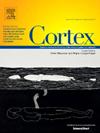First-person spoken narratives elicit consistent event structures in the angular gyrus
IF 3.3
2区 心理学
Q1 BEHAVIORAL SCIENCES
引用次数: 0
Abstract
Event segmentation theory explains how we parse a stream of continuous information into meaningful event models. Narratives are useful stimuli for studying this phenomenon, as the flow of information and the way we make meaning of them mirrors how we comprehend and make sense of our daily lives. Many studies have investigated the segmentation of audiovisual stimuli, such as movies, but only a handful of studies focused on how the brain parses auditory-only narrative. Using two stories with rich narrative features, we asked participants to listen to the story-recordings while being scanned with fMRI. We then recruited two separate groups of behavioral participants to parse the stories, either via transcript (visual-only) or recording (audio-only). Annotated boundaries from the two modalities were analyzed and used as behavioral benchmarks for the neural-behavioral comparison of event structures. We examined four regions of interest (angular gyrus, posterior cingulate cortex, early auditory cortex, and early visual cortex) and found that only the angular gyrus produced neural event structures that significantly matched with the behavioral event structures across both modalities and both stories. Our results indicate that activity in the angular gyrus is associated with the neural processes involved in parsing continuous narratives, particularly when these narratives are audio-only and contain ambiguous event transitions, rather than with changes in sensory-related features.
第一人称叙述在角回中引发一致的事件结构
事件分割理论解释了我们如何将连续信息流解析成有意义的事件模型。叙述是研究这一现象的有用刺激,因为信息的流动和我们理解它们的方式反映了我们如何理解和理解我们的日常生活。许多研究调查了视听刺激的分割,比如电影,但只有少数研究关注大脑如何解析听觉叙事。我们使用两个具有丰富叙事特征的故事,要求参与者一边听故事录音,一边接受功能磁共振成像扫描。然后,我们招募了两组不同的行为参与者来分析故事,要么通过文字记录(仅限视觉),要么通过录音(仅限音频)。分析了两种模式的注释边界,并将其用作事件结构的神经-行为比较的行为基准。我们检查了四个感兴趣的区域(角回、后扣带皮层、早期听觉皮层和早期视觉皮层),发现只有角回产生的神经事件结构在两种模式和两种故事中都与行为事件结构显著匹配。我们的研究结果表明,角回的活动与分析连续叙述的神经过程有关,特别是当这些叙述只有音频且包含模糊的事件转换时,而不是与感觉相关特征的变化有关。
本文章由计算机程序翻译,如有差异,请以英文原文为准。
求助全文
约1分钟内获得全文
求助全文
来源期刊

Cortex
医学-行为科学
CiteScore
7.00
自引率
5.60%
发文量
250
审稿时长
74 days
期刊介绍:
CORTEX is an international journal devoted to the study of cognition and of the relationship between the nervous system and mental processes, particularly as these are reflected in the behaviour of patients with acquired brain lesions, normal volunteers, children with typical and atypical development, and in the activation of brain regions and systems as recorded by functional neuroimaging techniques. It was founded in 1964 by Ennio De Renzi.
 求助内容:
求助内容: 应助结果提醒方式:
应助结果提醒方式:


